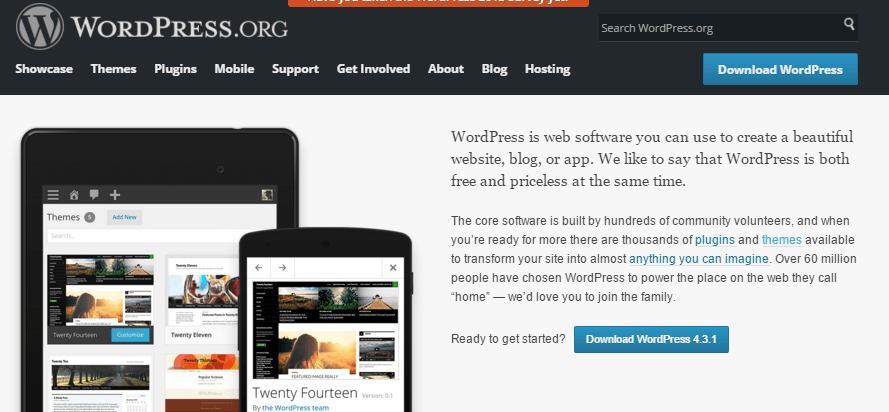Getting Started With WordPress: The Complete Guide
This is a post I created on the Interent marketing forum Black Hat World that I thought I would post here as well, so if something seems different about this post, then you know why.
For a while now, I’ve noticed that there are many new members who feel intimidated by the WordPress content management system (CMS), so they avoid it at all costs and continue using their Blogspot blogs or pre-made sites even though they really want to try something different. At one point in time, even I avoided migrating my sites to WordPress as I was worried about taking the plunge, but I eventually just went through with it and learnt how to use WordPress during the migration and I definitely don’t regret the decision. If you’re in a similar predicament or you’re just interested in getting started with WordPress, then this guide is for you, so keep reading and I’ll go over how to install WordPress, choose plugins, choose a theme, create a child theme, and even how to search engine optimise your settings.
Part 1: Installing WordPress

There are 2 easy ways to install WordPress: through your host’s cPanel and by manually uploading the WordPress CMS.
cPanel Installation

If you choose to install WordPress through your host’s cPanel, then you can easily do this by logging into your cPanel and going to a section called “applications”. Some hosts, such as HostGator, may have their WordPress installer in a section called “Special Offers”. If you’re unsure about where the host has placed the WordPress installer, then just use CTRL+F or CMD+F and type in “WordPress” without the quotes to open a search and find it on the page.
Once you click the WordPress installation button, the installer will have you choose a title, URL, username, password and upload destination for your site, so fill in this information and you’re all done.
Manual Installation

If your host doesn’t have a 1-click installer for WordPress, you can manually install WordPress by download the CMS to your computer from WordPress.org and follow the instructions below. The detailed instructions can be viewed on the WordPress website by clicking the previous link as well.
[QUOTE]
- Download and unzip the WordPress package if you haven’t already.
- Create a database for WordPress on your web server, as well as a MySQL user who has all privileges for accessing and modifying it.
- (Optional) Find and rename wp-config-sample.php to wp-config.php, then edit the file (see Editing wp-config.php) and add your database information.
- Upload the WordPress files to the desired location on your web server:
- If you want to integrate WordPress into the root of your domain (e.g. http://example.com/), move or upload all contents of the unzipped WordPress directory (excluding the WordPress directory itself) into the root directory of your web server.
- If you want to have your WordPress installation in its own subdirectory on your website (e.g. http://example.com/blog/), create the blog directory on your server and upload the contents of the unzipped WordPress package to the directory via FTP.
Note: If your FTP client has an option to convert file names to lower case, make sure it’s disabled.
[/QUOTE]
In case you’re wondering, there’s no real benefit to choosing one installation over the other (although the 1-click installation is quicker if you have it), so simply choose the one you find the most convenient. Once you’ve finished installing WordPress, you can move onto choosing a theme for your site
Part 2: Choosing A Theme

Choosing a theme can be a bit difficult as only you know what kind of website design would appeal to you and your target audience. Due to the aforementioned reasons and since there are so many themes to choose from, I’ve created a small list of websites below where you can search and download themes (both free and paid).
- https://wordpress.org/themes/
- http://themeforest.net/
- http://www.elegantthemes.com/
- http://www.templatemonster.com/wordpress-themes.php
- https://themify.me/
- https://colorlib.com/wp/free-wordpress-themes/
- https://www.simplethemes.com/
- http://cyberchimps.com/
- http://www.themeshaker.com/
- http://themebro.com/
- http://themesorter.com/
- http://www.wpthemeschecker.com/the-best-premium-wordpress-themes-for-2014/
- http://www.creativebloq.com/web-design/free-wordpress-themes-712429
- https://www.thebestdesigns.com/themes/
- http://www.codeinwp.com/blog/10-best-bootstrap-based-wordpress-themes/
Part 3: Creating A Child Theme
As if migrating to WordPress weren’t intimidating enough for some people, now they have to hear about creating a child theme if they ever want to make lasting changes to their current theme (so scary!). If you don’t know what a child theme is, it’s just a theme that uses the code from another theme (the “parent” theme) while having codes that modify or override the parent’s codes. While you can just make modifications to the parent theme, this usually isn’t recommend as when the parent theme is updated, any changes you made will be reverted.
Now, once you’ve selected a theme that you like, you can make modifications to it by creating a child theme. To create a child theme, what you want to do is go to your WordPress theme folder (this requires you to access your file manager, then you WP-Content folder, and then your themes folder) and create a new folder. This new folder will be your child theme folder, so name it whatever you want.
Next, you’re going to need to create a file called “Style.css”. Change the information below and be sure to change the template name in the @import url code (parent-theme-name) to your parent theme’s name, otherwise this won’t work. Additionally, you can use
[CODE]
/*
Theme Name: Child theme
Theme URI: http://www.example.com
Description: Child Theme
Author: Your name
Author URI: http://www.example.com
Template: parent theme name
Version: 1.0.0
*/
@import url(“../parent-theme-name/style.css”);
[/CODE]
Once you’ve created the style.css file, you can make any CSS changes to your website without them being overwritten when the theme is updated.
While I’ve never had an issues with @ import, you can instead create a functions.php file and paste the following information into it as a “faster and more flexible” way to load your parent theme’s information.
[CODE]
<?php
/**
* Enqueues child theme stylesheet, loading first the parent theme stylesheet.
*/
function themify_custom_enqueue_child_theme_styles() {
wp_enqueue_style( ‘parent-theme-css’, get_template_directory_uri() . ‘/style.css’ );
}
add_action( ‘wp_enqueue_scripts’, ‘themify_custom_enqueue_child_theme_styles’ );
[/CODE]
Really, that’s pretty much all there is to it. Of course, you may still be wondering how to make a few specific changes, so I’ve posted an example below to show you how you can make a simple change using your child theme’s css file.

Once you’ve followed the instructions in the image above, locate you parent theme’s CSS file and locate the same CSS code by performing a search for the element name (this will look like “.section-title”.) Copy the CSS code the way it is, paste it into your child theme’s CSS file, and make the changes there.
Part 4: Choosing Plugins

Ah, plugins. They are one of the reasons I decided to migrate to WordPress in the first place, but which plugins should you use? Well, I have a small list of must-have plugins that I like to use on nearly every site (although you don’t need to use all of them), and they are as follows:
- Wordfence Security: This is a security plugin that will send you an e-mail if there’s suspicious activity on your site as well as provide you will multiple security-related options (e.g., limiting login attempts). The premium version even comes with features that allow you to only sing into your site using your mobile device.
- Yoast SEO: This just makes doing on-page SEO easier by keeping track of your keyword density and providing you with fields to fill in meta information.
- Rename wp-login.php: This allows you to rename the wp-login pages and intercept any request to the original wp-login pages by presenting a 404 error page.
- Eggplant 301 Redirects: If you need an easy way to do 301 redirects on your site, then this plugin is for you.
- Cloudflare and CloudFlare Flexible SSL: If you plan on having caching or SSL enabled on your site respectively, then these two plugins help out significantly. For more information of enabling SSL on your WordPress site, read Pxoxrxn’s guide here.
- W3 Total Cache: Cloudflare’s plugin actually already has a caching feature, but if you would rather not use Cloudflare, then W3 Total Cache is another excellent choice.
- BJ Lazy Load: Some people don’t like images that lazy load, but I find that it speeds up my image-based site by loading images as the user scrolls down.
- EWWW Image Optimizer: This plugin compresses images, converts them from PNG to JPG, and even has a feature that allows you to bulk optimise your old and new images.
- Easy Slide-In for WordPress: This is a paid plugin that allows you to create a box that slides in from any corner of the screen. You can display forms, messages, and more with it! I found through a member on this forum, but I found it to be a great alternative to a pop-up feature.
- Awesome Surveys: It’s just a simple plugin that allows you to create surveys for your visitors to take. The surveys will also be e-mailed to you.
- Duplicator: This plugin allows you to backup, clone, and move your WordPress site from one location to the other. I actually just used this plugin to create a full backup of a site for one of my clients whose site is on GoDaddy (their backup system is archaic and broken), and it did its job well.
Remember, only download the ones you need and try to keep the number of plugins on your site as small as possible. Too many plugins can result in security vulnerabilities and a slow site as well as cause conflicting issues with other plugins.
Part 5: Search Engine Optimised Settings

While I’ve never had an issue with allowing search engines to index my category and tag pages, some members have reported issues with duplicate content by allowing them to index these pages, so if you’ve installed Yoast SEO on your site, you can no-index category pages and tag pages by logging into your WordPress dashboard, going to “SEO”, clicking on Titles & Meta, and then going to taxonomies. From here, you can no-index the category and tag pages by clicking the 2 boxes.
Also in your WordPress dashboard, you can go to your general settings and set your site title, tagline,and your site URL. There are other settings you can play around with as well, so be sure to set everything just the way you want it.
Under your permalink settings, you can also specify a separate folder for your blog by selecting the “custom structure” option and setting it to something like “/blog/%postname%/”. I usually create a blog page on my site and use a shortcodes plugin to display my articles there.
If you were previously dubious about whether or not you should use WordPress, then I hope this guide helped you make a decision. Good luck everyone on your future endeavours!
- My Experience Accepting Crypto Payments For The First Time - April 25, 2025
- Are Forums Dying? A Look Into Forums As A Whole - April 22, 2025
- Are The “Rank 1 In Google For Any Keyword” Services A Scam? - April 1, 2025


Leave a Reply